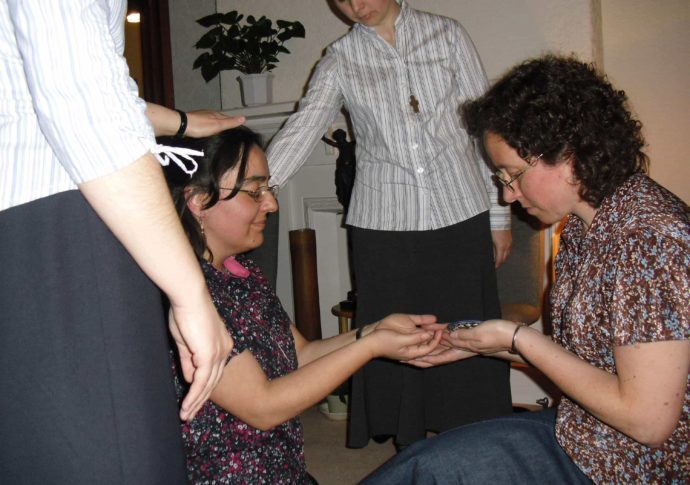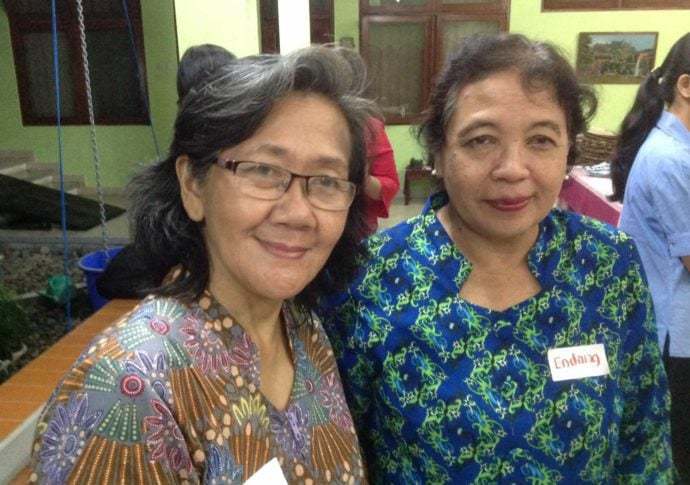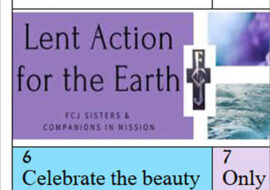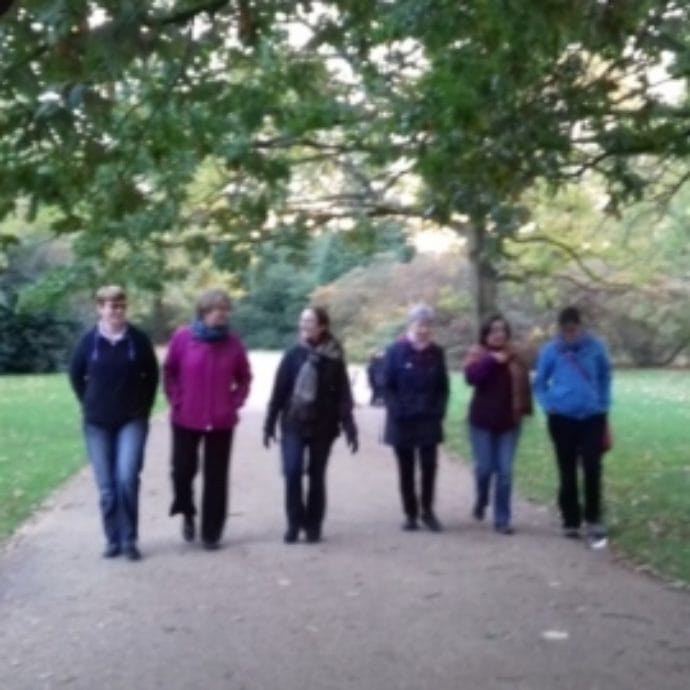Bloomsbury has just published a new book by Sr Teresa White fcJ, Hope and the Nearness of God, as their 2022 Lent Book. Here is a book review by Sr Rachel, fcJ
“Hope and the Nearness of God” by Teresa White fcJ is offered as a companion on the journey of Lent in this year of 2022. When Teresa was asked by the publishers if she had any suggestion for marketing her book, the fcJ website came to mind, whereupon they asked if she would find someone to write a book review. I was glad to accept the task, attracted by the title and the anticipation of the inspiration awaiting me.
It feels like a book that could only have been written by someone rich in years, someone who has read widely in literature and life, reflecting prayerfully the while and companioning with many amidst life’s joys and sorrows. I recall the disciple of the kingdom of heaven Jesus speaks of in Matthew 13:52, who brings out of his storeroom things both new and old. And what a storeroom, indeed, is here opened before us, with its feast of stories, poems, reflections and experiences, showing how the energy of hope has blessed, empowered and transformed so many people.
I love that the book has been designed to bring people together in small, informal shared-reading groups. If anything, these have proliferated since the covid pandemic drove us to Zoom, and in my experience have been powerful in deepening bonds of friendship and faith. Each chapter offers some suggestions to help us continue the conversation which each chapter has opened up. The book almost cries out to be used in this way. I look forward to using it with a weekly group, and will not be surprised if we continue to explore its riches through the six weeks of Easter as well as Lent. Even to share the journey of reading the book with just one or two other people would be immensely rewarding.
How appropriate it is to focus on hope at this time when it is so needed! In her Introduction, Teresa shares one of her favourite lines from Blaise Pascal: “In difficult times, carry something beautiful in your heart”. Writing as she did in the shadow of the coronavirus pandemic, it became clear to Teresa that this “something beautiful” could be hope, the hope we saw being longed for in the many rainbows that children coloured and placed in their windows. Yet, one of the strong points of the book is the unflinching and realistic admission that it is not hope but bad news that so often predominates, and with reason enough: “a threatened environment and deeply troubled human communities – a world where an existential anguish seems to float in the air we breathe.” Church and world are in such disarray:
We find ourselves questioning not just the Church but our faith in God …… Against this background, an injection of hope is surely needed.
Teresa White fcJ
The message of the book is that hope is a gift, but not a passive one, as we strive with God’s help to face life’s problems and do what we can to obtain the things we hope for, but in the context of hope, for hope brings transformation. The opening prayer which ends the Introduction gives us the ground plan of the whole book. We pray, „Oh God, remind us of your nearness, teach us to discern signs of hope in the reality of today. Open our eyes to see bridges of hope … open our ears to hear the melody of hope … Open our hearts to the energy of your Spirit, that we may begin each day confident of your care for us and for the whole of creation. Lord, be with us, in your love”.
Throughout the book, the challenge of holding to faith and hope is never downplayed. In the chapter on the providence of God we read: “It is sometimes said that in today’s world God is missing but not missed – and there is some truth in this. In this atmosphere, the gift of hope has an important role to play. Hope does miss God, seek God, long for God. Indeed that is the very essence of hope: to feel the lack, the absence, the distance, and in spite of these things, to place our confidence in God.” Story upon story shows how people like us embody hope, and forgiveness too, in the hardest of situations, demonstrating that love is stronger than evil, which is the heart of the good news of Jesus. The devotion of the Stations of the Cross is sensitively presented, with an extended reflection on the experience of Julian of Norwich, who through her contemplation of the Passion of Jesus came to know that God does not abandon us in suffering but shares it with us in solidarity, though like us Julian constantly questions why suffering should be permitted at all in a universe loved by God. Her 14th century was every bit as challenging as ours, with the Hundred Years’ War still going on and the Black Death sweeping through Norwich three times in her lifetime, and no vaccinations back then!
The chapter on Hope and Courage offers us as companions – among others – Anne Frank, Therese of Lisieux, Rowan Williams, poetry from Charles Peguy, the sad story of one of Teresa’s own young pupils who died tragically, and a moving reflection on the devotion of daily Mass as a desire to feel the touch of God, and of prayer as that which enables us to pass on the touch of God to others.
The chapter on signs and symbols shares surprising signs – surprising given the apparently faithless times in which we live – of a sense of the nearness of God: stories heard, words and actions witnessed, giving expression to hope and courage, and showing the kingdom of God already present in anticipatory and partial ways in our world. For example, the solidarity in caring for others which emerged during the pandemic, or the observed greater readiness to greet strangers and so become living signs of God’s presence. The ancient symbols of the cross and the anchor are featured, and the heaven-pointing spire of the Cathedral of Notre Dame, destroyed by fire yet within days promised to be restored. And the sobering reminder that hope is not the optimism that something will turn out well, but the certainty that something makes sense, regardless of how it turns out.
The chapter on Discerning Hope gives a beautiful account of spiritual discernment – taking on God’s perspective, seeing with God’s heart, and from within God’s heart. As the previous chapter said, most of us will be unable to do this if we are always busy, without some inwardness and stillness. Discernment leads us to see that the darkness of God may not signify absence but unseen and unknowable activity. There are no simple answers to suffering and the radical and disturbing mystery of death. Yet those who have hope can find the spiritual energy to face it without being totally crushed and embittered. Many real-life stories witnessing to this hope are shared.
After signs and symbols of hope we also have bridges to hope, such as music and poetry, walking, prayer, love and laughter. And the final chapter presents the Holy Spirit – God’s Indwelling Nearness – as the source of hope, for it is through the Spirit within us that we feel God’s solidarity when we are groping in the dark. All our “concrete petitions – for good weather, for security and employment, for healing, for basic necessities, for peace and reconciliation, for the homeless and the hungry – are simply our way of expressing our confidence in God’s nearness, and our expectation of his providential care for us.” The Spirit can be the force in the straining muscles of an arm, or the film of sweat between pressed cheeks; it can disturb and challenge as well as comfort; and truly comes to us yet does not linger. The Spirit does not work by stepping in to solve disasters, but by opening our wellsprings of compassion to bring hope in times of devastating suffering.
It is good news that Hope and the Nearness of God will be used in the Pray-As-You-Go app to lead many along our Lenten journey in its ten-minutes-a-day of music, reflection and prayer. This kind of step-by-step presentation seems ideal, for Hope and the Nearness of God is not a book to gallop through. At times, it feels like reading poetry: one must take it slowly and give it time to settle. Teresa says on page 1 that hope is one of those sacred words like gentleness and kindness, love and joy that “seem to draw us into the domain of God. Such words are in the truest sense poetic in that they communicate even before they are fully understood or analysed; indeed they lift human communication to a new level. They are a proof if we need one that though we live in time we are constantly being prompted to contemplate eternal realities.” I have no doubt that this book – born out of faith, hope and love – will give great glory to God by the encouragement it will bring to many, opening our hearts to joyful recognition of the Spirit who is ever with us in the energy of hope.


























